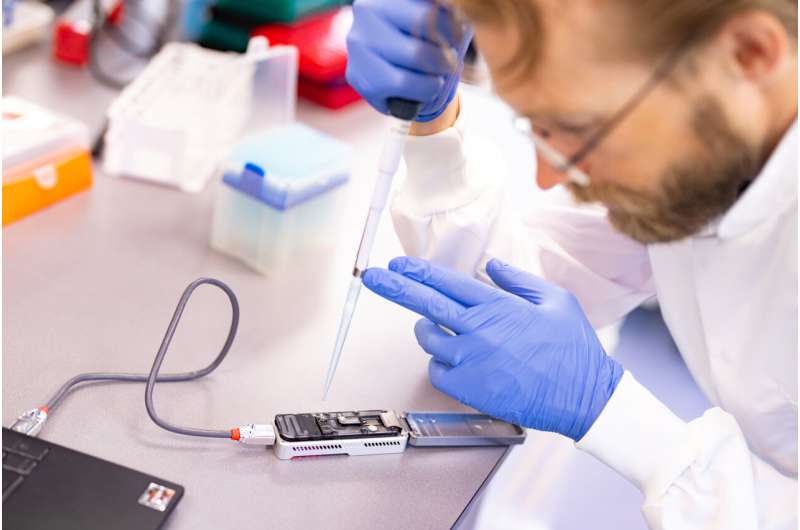This article has been reviewed according to Science X's editorial process and policies. Editors have highlighted the following attributes while ensuring the content's credibility:
fact-checked
peer-reviewed publication
trusted source
proofread
Study: AI speeds up identification of brain tumor type and can be used during surgery

What type of brain tumor does this patient have? AI technology helps to determine this as early as during surgery, within 1.5 hours. This process would normally take a week. The new technology allows neurosurgeons to adjust their surgical strategies on the spot. Today, researchers from UMC Utrecht and researchers, pathologists and neurosurgeons from the Princess Máxima Center for pediatric oncology and Amsterdam UMC have published a study on this topic in Nature.
Every year, 1,400 adults and 150 children are diagnosed with a tumor in the brain or spinal cord in the Netherlands. Surgery is often the first step taken in treatment. Currently, during surgery, neurosurgeons do not precisely know what type of brain tumor and what degree of aggressiveness they are dealing with. The exact diagnosis will usually only be available one week after surgery, after the tumor tissue has been visually and molecularly analyzed by the pathologist.
Deep-learning algorithm
Researchers from UMC Utrecht have developed a new "deep-learning algorithm," a form of artificial intelligence, which significantly speeds up diagnosis.
Jeroen de Ridder, research group leader within UMC Utrecht and Oncode Institute, explains, "Recently, Nanopore sequencing became available: a technology that helps to read DNA in real time. For this, we developed an algorithm that is equipped to learn from millions of simulated realistic 'DNA snapshots.' With this algorithm, we can identify the tumor type within 20 to 40 minutes. And that is fast enough to directly adjust the surgical strategy, if necessary."
de Ridder is in charge of a bioinformatics lab, consisting of 15 computational scientists. His team uses the latest developments in computer science, such as machine learning and artificial intelligence (AI), to analyze complex molecular datasets. That data is retrieved, for example, from tumor tissue taken from patients and is collected in biobanks.
"Modern technologies allow us to make enormously complex and rich measurements of, for instance, tumor biopsies," de Ridder says. "How do we ensure that that highly complex collection of measurement data leads to new fundamental insights about cancer? And how can we use that collected data to better diagnose and treat cancer?"
"To answer these questions, it is essential to design algorithms that can analyze large collections of molecular data, and that is exactly what bioinformatics focuses on. Although our research is fundamental in nature, we are driven to make sure that our findings will have a positive effect on patients' lives."
Tested and trained with biobank
Analyzing large amounts of data faster and more precisely is what de Ridder and his team do. For this specific new algorithm, they cooperated closely with Bastiaan Tops, head of the Laboratory for Pediatric Oncology at the Princess Máxima Center.
Tops brought together the new technology and the needs from the operating room. He provided the large amount of data that was needed to develop the algorithm: The Princess Máxima Center has maintained an extensive biobank for years. Among other things, this biobank stores tissue from children with brain tumors. The algorithm was trained and tested using this biobank.
"That we can now determine the type of brain tumor as soon as during surgery shows how technology can speed up diagnostics. And how we can use an existing biobank to develop a new technology, with great impact for future patients," says Bastiaan.
Used during surgery
Consequently, the whole procedure was also carried out several times during actual brain surgeries, from taking the tissue in the operating room to determining the tumor type. In Utrecht, this happened with children, and in Amsterdam with adults. The total length of the procedure was anywhere from 60 to 90 minutes.
The Princess Máxima Center has decided that the results of the technique are sufficiently reliable and is already using it with children for whom the outcome may determine the surgical strategy. Amsterdam UMC will also use the technique in daily practice, to help them speed up diagnosis.
Eelco Hoving, pediatric neurosurgeon and clinical director of neuro-oncology at the Máxima Center, is excited about the possibilities of DNA analysis during surgery.
"During surgery, a small remnant of tumor tissue is sometimes deliberately left behind to prevent neurological damage. But if it will later turn out, for example, that the tumor is very aggressive, a second surgery may still be necessary to remove that last remnant. This will again create risks and stress for patients and their families. This can be avoided now because we will already know during the first surgery what type of tumor we are dealing with," Hoving says.
de Ridder remarks, "It is wonderful that we have been able to actually make the step into clinical practice by combining all areas of expertise, from basic researchers to pathologists and surgeons. By doing so, we can help surgeons to optimize the outcome of brain tumor surgery."
To use the new technique even more widely and structurally, more research is needed. For instance, more tumor types should be added to the algorithm. In this way, international standards will be met, allowing comparison of data. Also, the outcomes of the new and current (lengthier) method will be further compared, in collaboration with other (inter)national centers. This should make clear whether the new method will also contribute to patients' quality of life in the long term.
More information: C. Vermeulen et al, Ultra-fast deep-learned CNS tumour classification during surgery, Nature (2023). DOI: 10.1038/s41586-023-06615-2




















